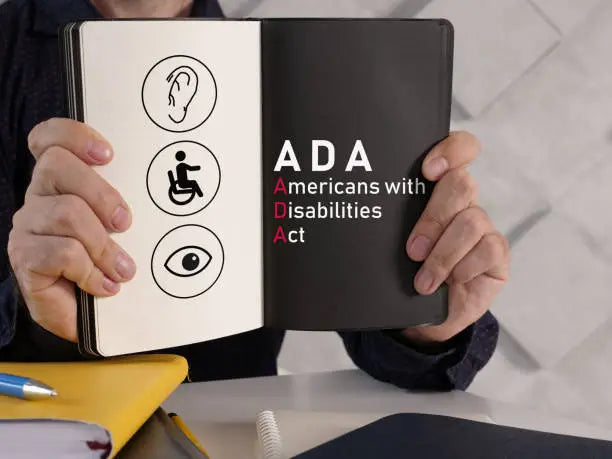
Understanding ADA & CMS Guidelines Regarding 4" Wall Projections in Healthcare Facilities
Share
ORIGINal Insights Newsletter
Understanding ADA & CMS Guidelines Regarding 4" Wall Projections in Healthcare Facilities: Compliance & Standardization with PPE Isolation Stations
In healthcare environments, accessibility, safety, and compliance are at the forefront of facility design and equipment placement. A critical regulation that impacts the installation of wall-mounted equipment, including PPE isolation stations and dispensers, is the Americans with Disabilities Act (ADA) and the Centers for Medicare & Medicaid Services (CMS) 4-inch wall projection rule. This guideline ensures that healthcare spaces remain accessible and safe for all individuals, including those with disabilities.
In this newsletter, we will explore the importance of these regulations, how 4-inch wall PPE isolation stations and dispensers contribute to compliance, and how standardizing PPE placement enhances both accessibility and use compliance in healthcare settings.
________________________________________________________________________________________
ADA & CMS 4" Wall Projection Guidelines: What You Need to Know
Understanding the 4" Projection Rule
The ADA Standards for Accessible Design (ADAAG) and CMS regulations require that wall-mounted objects cannot protrude more than 4 inches from the wall if they are placed between 27 inches and 80 inches above the floor. This rule ensures that individuals, particularly those who are visually impaired or using mobility aids (such as wheelchairs or walkers), do not accidentally collide with protruding objects in hallways, patient rooms, and other high-traffic areas.
These guidelines are particularly critical in hospitals, clinics, and long-term care facilities, where space optimization and accessibility are essential for patient and staff safety.
Why This Rule Matters in Healthcare
v Enhancing Patient & Staff Safety: Reducing wall projections prevents potential hazards, ensuring safe and navigable pathways throughout medical facilities.
v Supporting Accessibility Needs: Compliance with ADA regulations ensures that all individuals, including those with disabilities, can move freely without obstruction.
v CMS Compliance for Healthcare Accreditation: Facilities receiving Medicare and Medicaid reimbursements must meet CMS building regulations, which align with ADA standards for safety and accessibility.
________________________________________________________________________________________
How 4" Wall PPE Isolation Stations & Dispensers Ensure Compliance
The Role of PPE Stations in Healthcare
PPE (Personal Protective Equipment) isolation stations and dispensers play a crucial role in infection control and patient safety. These stations provide easy access to gowns, gloves, masks, face shields, shoe covers and more, ensuring that healthcare staff can quickly don necessary protective gear before entering patient rooms or high-risk areas.
However, traditional PPE storage solutions often protrude too far from the wall, leading to compliance challenges with ADA and CMS regulations. This is where 4-inch wall-compliant PPE dispensers become essential.
Benefits of 4" PPE Isolation Stations & Dispensers
v ADA & CMS Compliance: By maintaining a 4-inch or less wall projection, these dispensers ensure full compliance with accessibility regulations, allowing facilities to remain safe and legally compliant.
v Standardized PPE Placement: Installing PPE stations in consistent locations throughout a facility promotes efficiency and predictability, ensuring that healthcare workers always know where to access protective equipment in a fast-paced environment.
v Space Optimization in High-Traffic Areas: These low-profile dispensers allow hallways, patient rooms, and sterile corridors to remain clear and accessible, reducing the risk of obstruction and accidental collisions.
v Enhanced Infection Control & Organization: Wall-mounted dispensers prevent PPE from being placed on countertops or other non-sterile surfaces, reducing contamination risks while keeping PPE readily available.
________________________________________________________________________________________
Standardizing PPE Location for Efficiency & Compliance
Why Standardization Matters
Consistency in PPE placement eliminates confusion, reduces response times, and enhances compliance with infection prevention protocols. When PPE dispensers are located in predictable, ADA-compliant locations, staff can access equipment quickly in critical situations.
Best Practices for PPE Dispenser Placement
Near Patient Rooms & Isolation Areas: Ensuring PPE is readily available before entering a patient’s room reduces cross-contamination risks.
At Nurse Stations & High-Traffic Zones: Staff can grab necessary PPE before engaging with patients, ensuring a seamless workflow.
In Operating Rooms & Sterile Processing Areas: PPE should be strategically placed to maintain sterile environments and prevent disruptions during procedures.
Near Entrances & Exits of Designated Zones: This ensures staff and visitors don and doff PPE correctly, adhering to facility-wide infection control measures.
________________________________________________________________________________________
Conclusion: The Future of Compliance & PPE Storage in Healthcare
Meeting ADA and CMS guidelines does not have to be a challenge—4-inch PPE isolation stations and Semi-Recessed in-wall organizers provide a compliant, space-saving, and highly efficient solution for healthcare facilities looking to optimize workflow while maintaining safety standards.
By investing in compliant dispensers and standardizing PPE placement, facilities can enhance accessibility, reduce clutter, improve infection control, and ensure staff have immediate access to the protective gear they need.
Looking to upgrade your facility with ADA & CMS-compliant PPE dispensers? Explore our range of 4-inch wall PPE isolation stations and Semi-Recessed built in solutions to keep your healthcare environment safe, efficient, and fully compliant!
FAQ's:
1. What is the ADA 4-inch wall projection rule?
The ADA requires that wall-mounted objects cannot protrude more than 4 inches from the wall when placed between 27–80 inches above the floor, ensuring safe passage for people with disabilities.
2. Why is the 4-inch rule important in healthcare facilities?
It protects patients, staff, and visitors—especially those with mobility aids or visual impairments—by keeping hallways and patient areas clear of obstructions.
3. How do PPE isolation stations meet ADA & CMS compliance?
Specially designed dispensers maintain a low-profile projection of 4 inches or less, ensuring accessibility while providing easy access to gloves, masks, gowns, and other PPE.
4. What are the benefits of standardizing PPE dispenser placement?
Consistent, compliant placement improves staff efficiency, reduces response time, enhances infection prevention, and ensures equipment is always accessible when needed.
Contact us today to find the perfect PPE storage solution for your facility!
